The Top 10 Hospital AV Solutions: Enhancing Patient Care and Communication
The healthcare industry is constantly evolving, and advancements in technology have greatly impacted patient care and communication. With the increasing demand for quality healthcare services, hospitals and healthcare facilities are turning to Audio-Visual (AV) solutions to enhance patient care, communication, and workflow. In this article, we will explore the top 10 hospital AV solutions that are transforming the healthcare industry.
Table of Contents
a. What are Digital Signage Solutions?
Digital signage solutions are a type of digital media that can be used to display information, such as news, weather, and time, on screens in public places. In hospitals, digital signage solutions can be used to provide information about patient care, hospital services, and hospital events.
b. How can Digital Signage Solutions Benefit Hospitals?
There are many benefits to using digital signage solutions in hospitals. Some of the benefits include:
- Improved patient care: Digital signage solutions can be used to provide patients with information about their care, such as their medications, their treatment plan, and their discharge instructions. This can help patients to understand their care and to comply with their treatment plan.
- Increased efficiency: Digital signage solutions can be used to provide staff with information about hospital services, such as the location of different departments, the hours of operation, and the availability of staff. This can help staff to be more efficient and to provide better service to patients.
- Reduced costs: Digital signage solutions can be used to replace traditional signage, such as paper posters and flyers. This can help hospitals to reduce costs.
- Improved communication: Digital signage solutions can be used to communicate with patients, staff, and visitors. This can help to improve communication and to create a more positive and welcoming environment in the hospital.
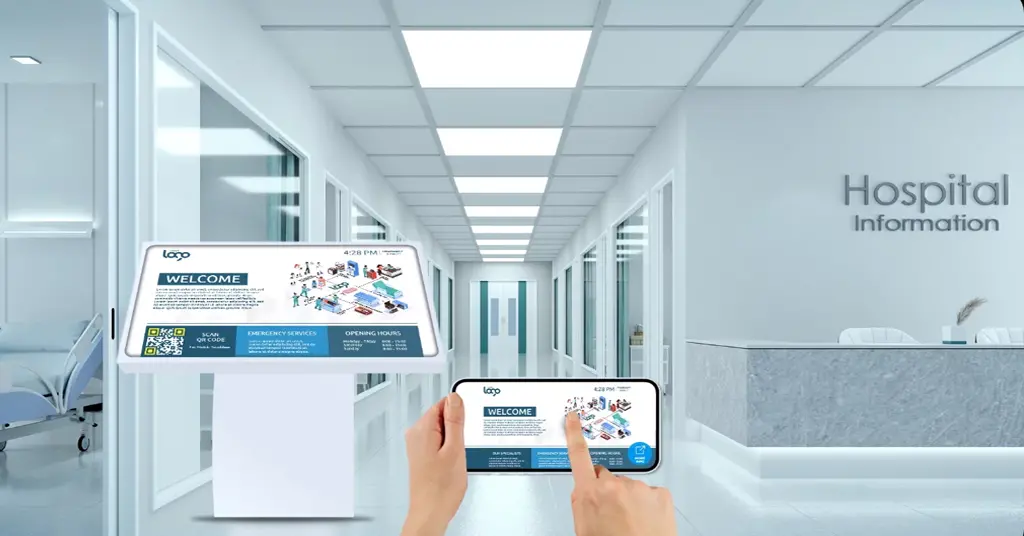
c. Examples of Digital Signage Solutions for Hospitals
There are many different types of digital signage solutions that can be used in hospitals. Some of the most common types of solutions include:
- Wayfinding: Digital signage solutions can be used to help patients and visitors find their way around the hospital.
- Patient education: Digital signage solutions can be used to provide patients with information about their care, such as their medications, their treatment plan, and their discharge instructions.
- Staff education: Digital signage solutions can be used to provide staff with information about hospital services, such as the location of different departments, the hours of operation, and the availability of staff.
- Marketing: Digital signage solutions can be used to promote hospital services and to generate revenue.
- Public service announcements: Digital signage solutions can be used to provide information about public health and safety concerns.
a. What are Telemedicine Solutions?
Telemedicine solutions are a type of technology that allows patients to connect with healthcare providers remotely. This can be done through video conferencing, phone calls, or text messaging. Telemedicine solutions can be used to provide a variety of services, including:
- Primary care visits
- Mental health consultations
- Specialist consultations
- Medication management
- Disease management
- Case management
b. How can Telemedicine Solutions Benefit Hospitals?
There are many benefits to using telemedicine solutions in hospitals. Some of the benefits include:
- Increased access to care: Telemedicine solutions can help hospitals to increase access to care for patients who live in rural areas or who have difficulty traveling to the hospital.
- Reduced costs: Telemedicine solutions can help hospitals to reduce costs by reducing the need for patients to travel to the hospital and by reducing the need for hospital staff to travel to patients’ homes.
- Improved patient satisfaction: Telemedicine solutions can help hospitals to improve patient satisfaction by providing patients with convenient access to care and by reducing the amount of time that patients spend waiting for care.
- Increased quality of care: Telemedicine solutions can help hospitals to improve the quality of care by providing patients with access to experienced healthcare providers and by providing patients with access to specialized care.
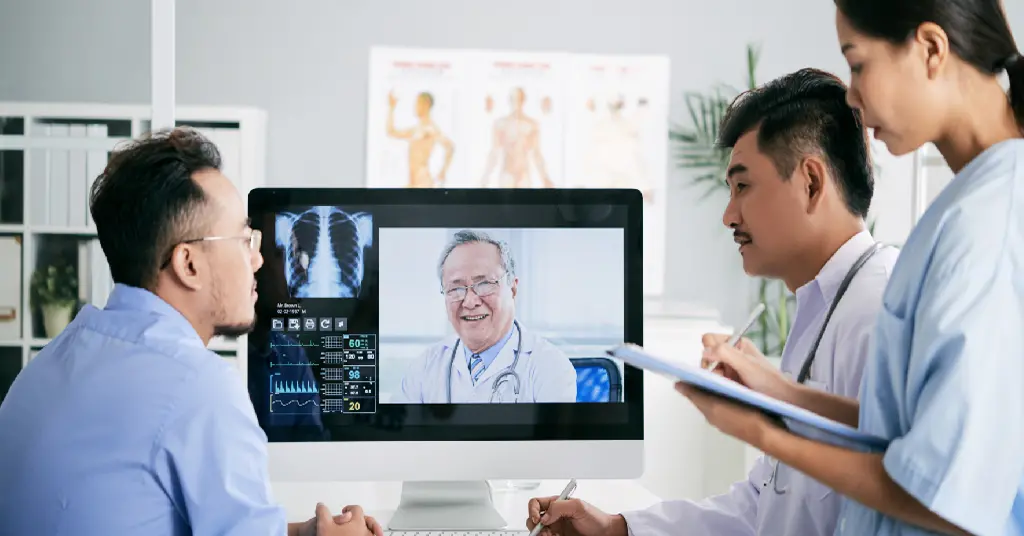
c. Examples of Telemedicine Solutions for Hospitals
There are many different types of telemedicine solutions that can be used in hospitals. Some of the most common types of solutions include:
- Video conferencing: Video conferencing allows patients to connect with healthcare providers remotely through a video connection.
- Phone calls: Phone calls allow patients to connect with healthcare providers remotely through a phone call.
- Text messaging: Text messaging allows patients to connect with healthcare providers remotely through text messages.
- Online portals: Online portals allow patients to access their medical records, schedule appointments, and communicate with healthcare providers remotely.
- Mobile apps: Mobile apps allow patients to access their medical records, schedule appointments, and communicate with healthcare providers remotely.
a. What are Video Conferencing Solutions?
Video conferencing solutions are a type of software that allows users to communicate with each other in real time over the internet using video and audio. This can be used for a variety of purposes, such as for doctor-patient consultations, patient-to-patient consultations, and employee training.
b. How can Video Conferencing Solutions Benefit Hospitals?
Video conferencing solutions can benefit hospitals in a number of ways, such as by:
- Reducing the need for patients to travel to the hospital
- Allowing patients to consult with doctors from anywhere in the world
- Facilitating collaboration between different departments within a hospital
- Providing a more engaging and personalized experience for patients
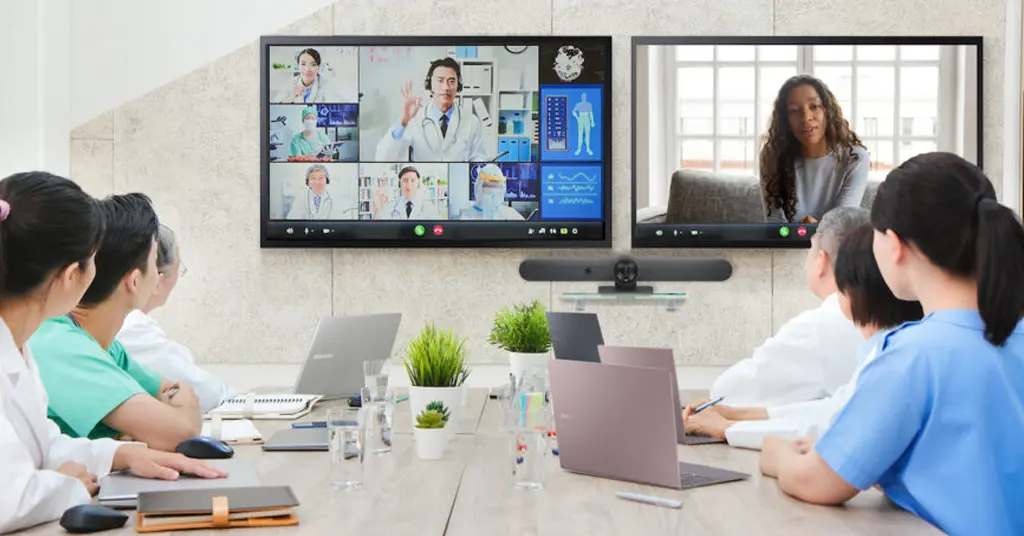
c. Examples of Video Conferencing Solutions for Hospitals
Some examples of video conferencing solutions for hospitals include:
- RingCentral Video
- Teladoc
- Zoom
- Microsoft Teams
- Google Meet
These solutions offer a variety of features, such as high-quality video and audio, screen sharing, and remote control. They can also be integrated with other hospital systems, such as electronic health records (EHRs).
a. What are Patient Entertainment Solutions?
Patient entertainment solutions are a type of technology that is designed to provide patients with access to entertainment during their hospital stay. This can include anything from television and movies to video games and music. Patient entertainment solutions can help to improve patient satisfaction and reduce boredom during hospital stays.
b. How can Patient Entertainment Solutions Benefit Hospitals?
Patient entertainment solutions can benefit hospitals in a number of ways. First, they can help to improve patient satisfaction. Studies have shown that patients who have access to entertainment during their hospital stay are more likely to be satisfied with their care. Second, patient entertainment solutions can reduce boredom. Boredom can lead to anxiety and depression, which can have a negative impact on a patient’s recovery. Third, patient entertainment solutions can help to reduce costs. Patient entertainment solutions can help to reduce the amount of time that patients spend in the hospital, which can lead to lower costs for the hospital.
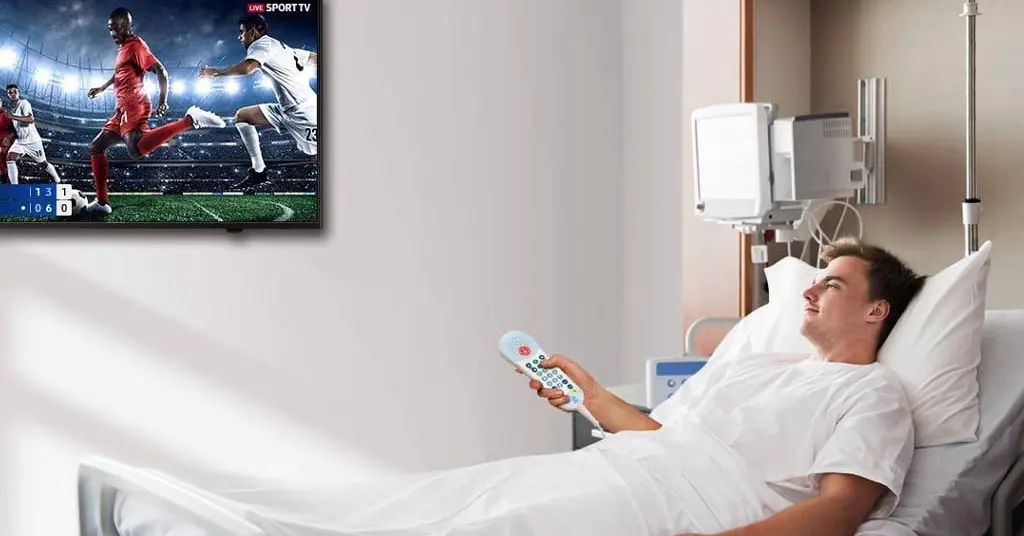
c. Examples of Patient Entertainment Solutions for Hospitals
There are a number of different types of patient entertainment solutions available. Some of the most common types of patient entertainment solutions include:
- Televisions and movies
- Video games and music
- Internet access
- Personal devices
- Interactive patient education systems
The best type of patient entertainment solution for a hospital will depend on the specific needs of the hospital and its patients.
a. What are Interactive Whiteboards and Displays?
Interactive whiteboards and displays are electronic devices that allow users to interact with their content in a more engaging and collaborative way. They are typically used in classrooms and workplaces, but they can also be found in hospitals and other healthcare settings. Interactive whiteboards and displays can be used for a variety of purposes, including:
- Presentations
- Teaching and learning
- Collaboration
- Decision making
b. How can Interactive Whiteboards and Displays Benefit Hospitals?
Interactive whiteboards and displays can benefit hospitals in a number of ways. First, they can help to improve patient education. Patients can use interactive whiteboards and displays to learn about their condition, treatment options, and self-care. Second, interactive whiteboards and displays can help to improve communication between patients and their care team. Patients can use interactive whiteboards and displays to ask questions, share their concerns, and track their progress. Third, interactive whiteboards and displays can help to improve the quality of care. Interactive whiteboards and displays can be used to track patient progress, identify potential problems, and make decisions about care.
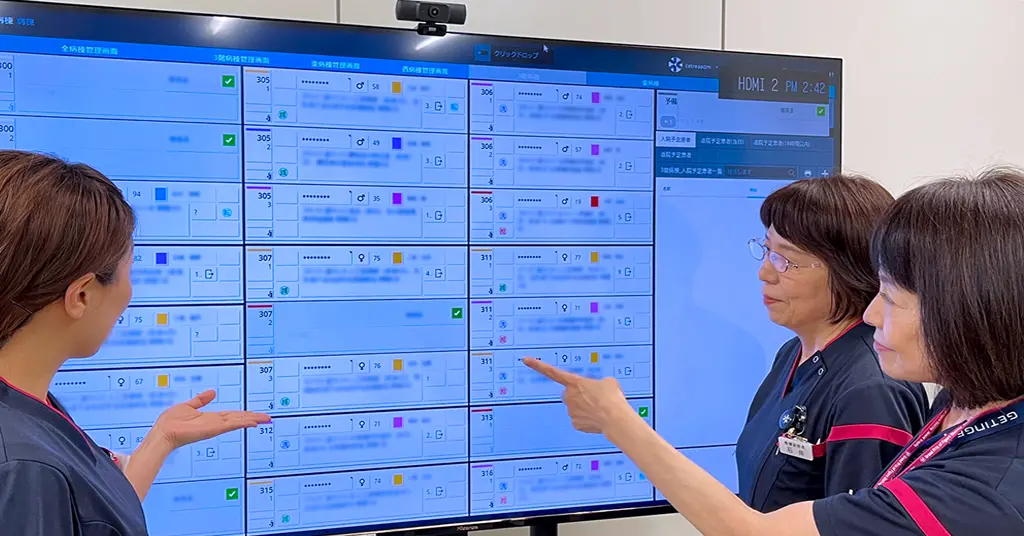
c. Examples of Interactive Whiteboards and Displays for Hospitals
There are a number of different types of interactive whiteboards and displays available for hospitals. Some of the most common types of interactive whiteboards and displays include:
- Touch-screen displays
- Interactive digital whiteboards
- Video conferencing systems
- Virtual reality systems
The best type of interactive whiteboard or display for a hospital will depend on the specific needs of the hospital and its patients.
a. What are Audio Solutions?
Audio solutions are systems that provide sound reinforcement or audio playback in a variety of settings. They can be used in hospitals to improve communication, provide background music, and provide emergency notifications.
b. How can Audio Solutions Benefit Hospitals?
Audio solutions can benefit hospitals in a number of ways. For example, they can:
- Improve communication between staff and patients. This can be done by using audio systems to page staff, make announcements, and provide instructions.
- Provide background music to create a more relaxing and calming atmosphere for patients.
- Provide emergency notifications to alert staff and patients to danger.
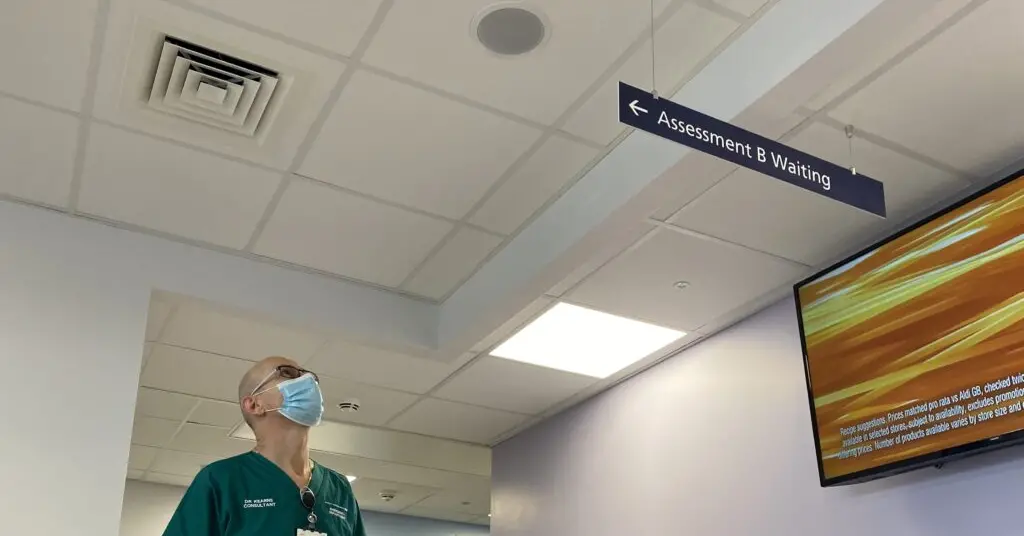
c. Examples of Audio Solutions for Hospitals
There are a number of different audio solutions that can be used in hospitals. Some common examples include:
- Paging systems: These systems allow staff to communicate with each other over a loudspeaker system.
- Music systems: These systems provide background music in waiting rooms, corridors, and other areas of the hospital.
- Emergency notification systems: These systems alert staff and patients to danger, such as a fire or medical emergency.
a. What are Wayfinding Solutions?
Wayfinding solutions are systems that help people navigate indoor and outdoor spaces. They can be used in hospitals to help patients and visitors find their way around the building, to their appointments, and to other areas of the hospital.
b. How can Wayfinding Solutions Benefit Hospitals?
Wayfinding solutions can benefit hospitals in a number of ways. They can:
- Reduce stress and anxiety for patients and visitors.
- Improve the patient experience.
- Increase efficiency and productivity.
- Enhance security.
- Save money.
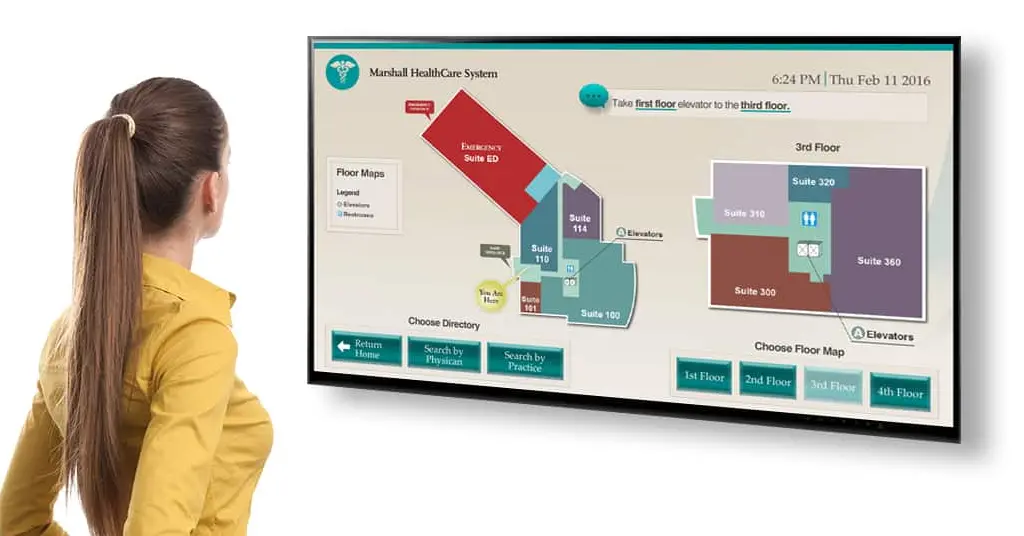
c. Examples of Wayfinding Solutions for Hospitals
There are a number of different wayfinding solutions that can be used in hospitals. Some common examples include:
- Digital signage: This can be used to display maps, directions, and other information.
- Physical signage: This can be used to mark exits, stairs, and other important areas.
- Wayfinding apps: These can be used to provide real-time directions and information on mobile devices.
- Interactive maps: These can be used to allow users to explore the hospital campus and find their way around.
- GPS navigation: This can be used to provide turn-by-turn directions to specific locations.
a. What are LED Video Walls?
LED Video walls are a type of display that consists of multiple LED display panel arranged in a grid or other pattern. They can be used to display a variety of content, including live video, images, and text. Video walls are often used in hospitals to provide information and entertainment to patients and visitors.
b. How can LED Video Walls Benefit Hospitals?
LED Video walls can benefit hospitals in a number of ways. They can:
- Improve patient satisfaction: Video walls can provide patients with a sense of comfort and familiarity by displaying images of nature or their loved ones. They can also provide patients with information about their treatment and condition, which can help them feel more in control.
- Reduce stress and anxiety: Video walls can help reduce stress and anxiety for patients by providing them with a distraction from their surroundings. They can also help patients feel more connected to their community by displaying images of local events and landmarks.
- Enhance the patient experience: Video walls can enhance the patient experience by providing them with a more comfortable and engaging environment. They can also help patients feel more connected to their care team by displaying images of their doctors and nurses.
- Improve staff morale: Video walls can improve staff morale by providing them with a sense of pride in their work. They can also help staff feel more connected to their patients by displaying images of patients and their families.
- Increase efficiency: Video walls can increase efficiency by providing staff with a way to communicate with each other and with patients. They can also help staff stay up-to-date on the latest news and information.

c. Examples of LED Video Walls for Hospitals
There are a number of different ways that video walls can be used in hospitals. Some common examples include:
- Patient education: Video walls can be used to provide patients with educational information about their treatment and condition. This can help patients feel more in control and can also reduce stress and anxiety.
- Wayfinding: Video walls can be used to provide patients and visitors with wayfinding information. This can help them find their way around the hospital and can also reduce stress and anxiety.
- Entertainment: Video walls can be used to provide patients and visitors with entertainment. This can help them relax and can also help reduce stress and anxiety.
- Staff communication: Video walls can be used to communicate with staff. This can help staff stay up-to-date on the latest news and information and can also help reduce stress and anxiety.
a. What are Wireless Presentation Solutions?
Wireless presentation solutions are systems that allow users to share content from their devices without the need for cables. This can be useful in hospitals, as it allows doctors and nurses to share information with patients and each other without having to worry about wires getting in the way.
b. How can Wireless Presentation Solutions Benefit Hospitals?
Wireless presentation solutions can benefit hospitals in a number of ways. They can:
- Improve communication: Wireless presentation solutions can help doctors and nurses communicate more effectively with each other and with patients. This can help to improve the quality of care that patients receive.
- Improve efficiency: Wireless presentation solutions can help hospitals to be more efficient. This is because they allow doctors and nurses to share information quickly and easily.
- Improve patient satisfaction: Wireless presentation solutions can help to improve patient satisfaction. This is because they allow patients to be more involved in their own care.

c. Examples of Wireless Presentation Solutions for Hospitals
There are a number of different wireless presentation solutions that can be used in hospitals. Some common examples include:
- Wireless projectors: Wireless projectors allow users to project images and videos from their devices onto a screen.
- Wireless document cameras: Wireless document cameras allow users to share documents and images from their devices onto a screen.
- Wireless interactive whiteboards: Wireless interactive whiteboards allow users to share content from their devices onto a screen and interact with it.
- Wireless presentation software: Wireless presentation software allows users to share content from their devices onto a screen without the need for a wireless projector or document camera.
a. What are Room Scheduling Solutions?
Room scheduling solutions are software programs that help hospitals manage their room schedules. They can be used to book rooms for appointments, surgeries, and other events. Room scheduling solutions can help hospitals to improve efficiency, reduce costs, and improve patient care.
b. How can Room Scheduling Solutions Benefit Hospitals?
Room scheduling solutions can benefit hospitals in a number of ways. They can:
- Improve efficiency: Room scheduling solutions can help hospitals to be more efficient by reducing the amount of time that it takes to book rooms. This can free up staff time so that they can focus on other tasks.
- Reduce costs: Room scheduling solutions can help hospitals to reduce costs by reducing the amount of time that it takes to book rooms. This can also help to reduce the amount of money that is spent on unnecessary rooms.
- Improve patient care: Room scheduling solutions can help hospitals to improve patient care by ensuring that patients are seen in a timely manner. This can also help to reduce the amount of time that patients spend waiting for appointments.
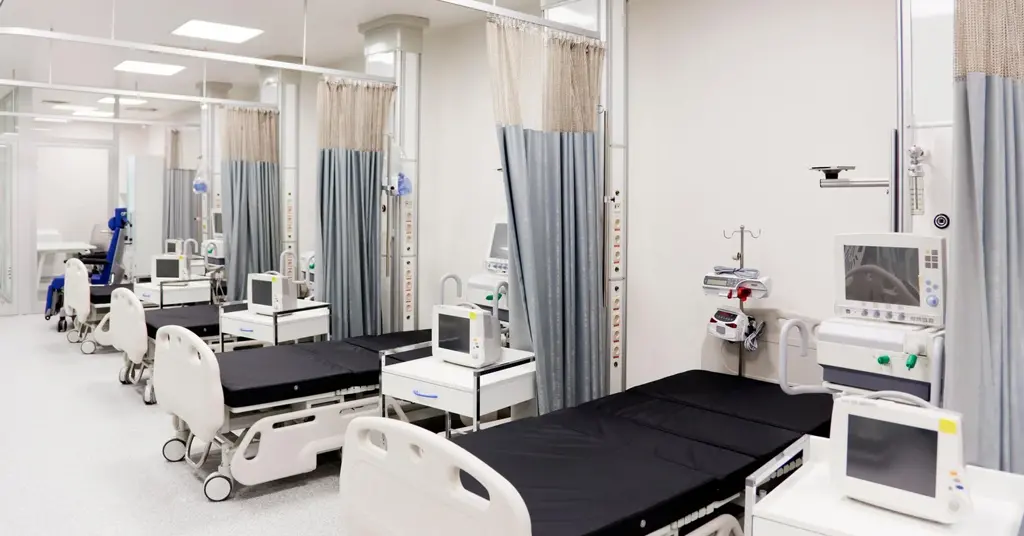
c. Examples of Room Scheduling Solutions for Hospitals
There are a number of different room scheduling solutions that can be used by hospitals. Some common examples include:
- Centralized scheduling: Centralized scheduling is a type of room scheduling solution that allows hospitals to manage their room schedules from a central location. This can be helpful for hospitals that have multiple locations.
- Decentralized scheduling: Decentralized scheduling is a type of room scheduling solution that allows hospitals to manage their room schedules from individual departments. This can be helpful for hospitals that have a lot of different departments.
- Mobile scheduling: Mobile scheduling is a type of room scheduling solution that allows hospitals to manage their room schedules from mobile devices. This can be helpful for hospitals that have a lot of staff who are on the go.
Want to know more about the Audio Visual Solutions?
